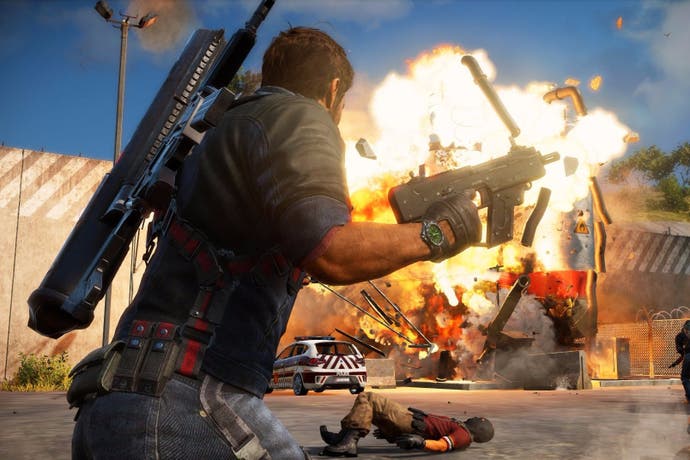What does it take to run Just Cause 3 at 1080p60?
PC hardware testing in search of the fastest, smoothest gameplay experience.
One of the most eagerly awaited titles of the holiday period, Avalanche Studios' Just Cause 3 delivers almost everything you might have been hoping for - a lush, beautiful open world packed with adventure, wonderfully insane physics and colossal, immensely enjoyable explosions. There's just one problem: performance. The consoles fall some way short of delivering a consistent 30fps, and for many, that does diminish the fun factor - especially on Xbox One. Suffice to say that if you're looking for a truly transformative experience, PC is the way to go. 1080p60 gameplay is attainable, with equivalent levels of performance also possible at 1440p and higher. Although frame-rates are obviously lower, Just Cause 3 is even perfectly playable at 4K, completely maxed and using just one GPU.
But unfortunately, to get the best results, our tests reveal that Avalanche's game isn't exactly suited to the plurality of PC hardware. To consistently hit the best levels of performance, an Intel CPU is required, paired with an Nvidia graphics card. On the face of it, this may seem like the best combination of parts to optimise for - after all, Intel and Nvidia are each reckoned to possess around 80 per cent of market share in the CPU and discrete graphics market respectively. However, there are many users out there with AMD CPUs or GPUs, and our testing here shows a less than ideal picture.
First up, let's talk about our testing techniques for this title. We used four platforms in total for our analysis - at the budget end of the scale, our value PC based on a Core i3 4130 with 8GB of DDR3 is utilised. Moving up to mid-range parts, we tested the GTX 960 and the R9 380 with both a Core i5 4690K and an FX-8350 paired with the same memory. And finally, moving to the high-end cards, we matched these with our freshly minted Core i7 6700K system, running 16GB of 2666MHz DDR4. Put simply, the idea here is to match processors to graphics cards in order to better reflect real-life set-ups.
At the budget end of the scale, 1080p60 is not really an option - you'll need a higher level of CPU power and the quartet of graphics cards tested also fall some way short. We used something approaching maximum settings here at 1080p, with just minor compromises: shadows drop to high from very high, we used 8x anisotropic filtering instead of 16x and we also opted for straight SMAA anti-aliasing as opposed to the temporal SMAA T2X.
| 1920x1080, Core i3 4130, Custom Settings | Lowest FPS | Average FPS |
|---|---|---|
| Radeon R7 360 | 24.0 | 33.3 |
| GeForce GTX 750 Ti | 23.0 | 29.7 |
| Radeon R7 370 | 23.0 | 35.4 |
| GeForce GTX 950 | 35.0 | 45.0 |
- Click on the links above to buy these graphics cards from Amazon with free shipping.
In terms of entry-level GPUs, AMD's R7 360 handily outperforms our budget favourite - the GTX 750 Ti, and it does it with a 12 per cent improvement in overall performance across test clips encompassing blasting, driving, flying and shooting. Now, there is an issue we found in virtually all AMD cards running this game - specifically occasional stutter during traversal and a much more pronounced issue during physics-heavy, explosive sequences. However, in the 30-35fps areas these cards inhabit, the hitches in performance are less of an issue. It's just a shame that AMD still has no solution for properly frame-paced 30fps with v-sync - the console standard.
GTX 750 Ti, once overclocked, keeps you at 30fps for the vast majority of the duration but we had to use half-rate adaptive v-sync - lock at 30, tear beneath. Nvidia Inspector's 30fps cap exhibited profound double-buffering issues, which didn't seem to improve that much once hardware triple-buffering was forced. Even with higher-end hardware, Just Cause 3 has issues with v-sync. For best stability with these cards, dropping LOD factor and utilising FXAA should help.
Moving up to GTX 950 gives a huge boost to performance with handsome frame-rate averages, though we'd still use it with a 30fps lock and maxed out quality settings. AMD's alternative here - the R7 370 (effectively an overclocked Radeon HD 7850) exhibited some of the harshest stutter we experienced in our testing. The experience really wasn't great, as you can see in the video above.
| 1920x1080, Max Settings | Lowest FPS | Average FPS |
|---|---|---|
| Core i5 4690K/Radeon R9 380 | 33.0 | 50.3 |
| Core i5 4690K/GeForce GTX 960 | 38.0 | 47.5 |
| FX-8350/Radeon R9 380 | 32.0 | 48.2 |
| FX-8350/GeForce GTX 960 | 30.0 | 40.8 |
- Click on the links above to buy these CPUs and graphics cards from Amazon with free shipping.
Moving onto the mid-range cards, we increase quality settings to the maximum and pit the GTX 960 up against the R9 380 - the AMD card historically commanding a tangible performance lead over its GeForce counterpart. On paper, from a pure benchmarking perspective, AMD's lead here is tangible, but the 5fps minimum frame-rate advantage of the GeForce card is telling - across the entire stack, Nvidia simply has more consistency in its performance 'under fire' with only very minor stutter.
Checking out our minigun gameplay sequence, featuring a number of NPCs, vehicles and explosions, there's a remarkable section where simply firing the gun depresses performance on the AMD card, eliminating its in-the-moment advantage over the GTX 960. Meanwhile, the Nvidia product maintains consistency in the same scenario. This kind of sudden drop in performance is really unexpected.
We also tested the AMD FX-8350 processor on both of these cards, noting that moving from an i5 to the AMD chip produced two very different results for each GPU vendor. General performance is compromised substantially on Nvidia - producing anything up to a 10fps drop during 'in the moment' like-for-like gameplay. Meanwhile, the R9 380 retained almost all of its overall performance in terms of frame-rate averages, but more stutter seems to be introduced in high frame-rate areas with a lot of explosive action. Further testing with AMD CPUs proved problematic owing to frequent crashing issues on our platform here (we also had similar, if less frequent issues with the i5, but none at all with two i7 systems).
| 1920x1080, Max Settings | Lowest FPS | Average FPS |
|---|---|---|
| Radeon R9 390 | 43.0 | 68.5 |
| GeForce GTX 970 | 57.0 | 70.5 |
- Click on the links above to buy these graphics cards from Amazon with free shipping.
Nvidia's GTX 970 is a sales phenomenon. It's the most widely used discrete graphics card based on Steam's hardware survey - quite the achievement for a card with a relatively high retail price and that controversy surrounding it. It's generally the 'go to' piece of kit for 1080p60 PC gameplay, performing very well with Just Cause 3. The 970 is available generally in various factory-overclocked guises, but our model is a basic Zotac model has a mere 20MHz speed bump to the core, making it little better than stock in real-life gameplay conditions. By contrast, its competitor in our GPU stack - the Radeon R9 390 in its Asus Direct CU 3 incarnation - comes with a 70MHz factory overclock out of the box, making it a fierce contender.
Results-wise, there's little in it in terms of average frame-rates: a mere three per cent advantage to GTX 970, and for the bulk of our tests, the experience does feel like-for-like. But again, there is the stutter issue on AMD hardware - less pronounced in this test than elsewhere, but still impactful - minimum frame-rate on GTX 970 is 14fps higher.
Pairing an Intel quad-core processor with GTX 970 seems to be the best combination for running Just Cause 3 at 1080p60 with all settings maxed, but once again, v-sync does seem to be an issue and we would recommend the GPU adaptive option to give the title a small amount of elasticity in its render budget.
| Max Settings | 4K Low FPS | 4K Avg FPS | 1440p Low FPS | 1440p Avg FPS |
|---|---|---|---|---|
| Radeon R9 Fury X | 26.0 | 35.6 | 37.0 | 59.0 |
| GeForce GTX 980 Ti | 31.0 | 38.2 | 55.0 | 70.4 |
- Click on the links above to buy these graphics cards from Amazon with free shipping.
Are you looking to run Just Cause 3 at 1440p or 4K? Well, the game is highly scalable and it's possible to get a perfectly playable experience with all settings maxed at ultra HD resolution. In fact, both GTX 980 Ti and R9 Fury X are capable of beating the 1080p performance of our budget cards at 4x the resolution and with settings pushed up to the max. On balance, GTX 980 Ti hands in best performance at 4K, with a seven per cent performance advantage, and again, there are minimum frame-rate advantages too - though the generally lower frame-rates seen running the game at 4K seems to reduce the impact of the latency spikes seen on AMD hardware.
There's another interesting story in scalability here too in that the GTX 980 Ti offers a performance profile that's very similar to the GTX 970 - only what the cheaper card achieves at 1080p, the GTX 980 Ti matches at 2560x1440. Fury X really doesn't cope too well at 1440p - performance is highly variable, to the point where Nvidia hardware is 20 per cent faster across the board with a substantial 18fps deficit on the lowest recorded frame-rate. It's the same inconsistency in performance seen on other hardware, and it's disappointing to see a top tier piece of hardware let down by the software side.
We've investigated a number of community-driven attempts to address this problem, with suggestions including adjusting audio configuration and turning off overlays (which we use to measure performance - we dropped back to our console analysis tools here) - and we've tested across three different CPUs, five GPUs and two operating systems, and nothing can change the outcome, but it should be stressed that the hitching does seem to manifest to varying degrees on various cards at various resolutions, so your mileage may vary if you own AMD graphics hardware. It's been the most major point of differentiation in our analysis but for the most part, what we're seeing here is nothing like as severe as the problems seen in, say, Batman Arkham Knight. However, this issue - along with the intermittent crashing issues we experienced on some of our set-ups - does highlight the importance of a QA process that encompasses the plurality of PC hardware and the need to ensure optimal driver support for day one.













